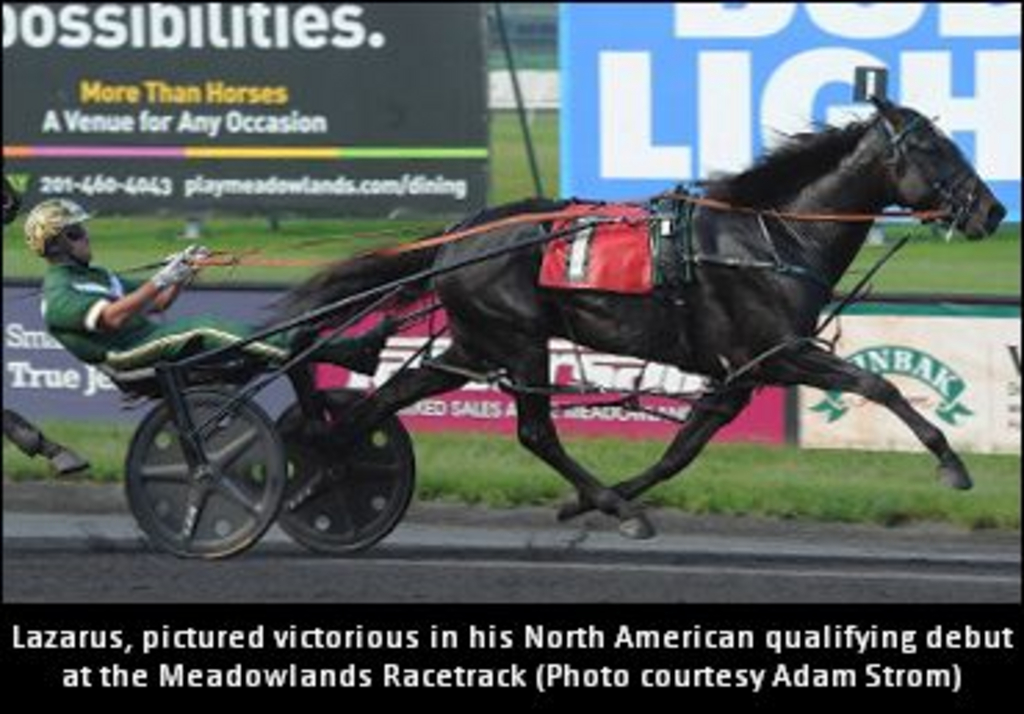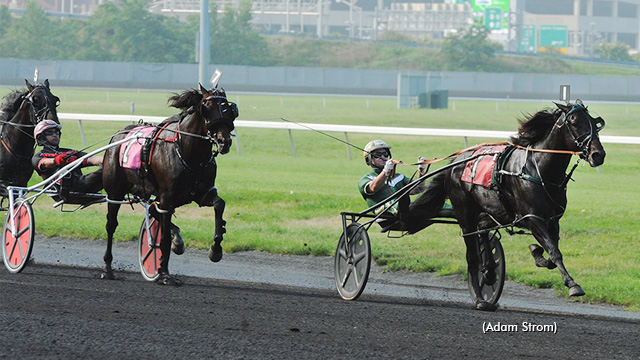Plans For Lazarus’ Debut Unveiled

 After having made his North American debut with a 1:48.3 qualifying mile this past Saturday (July 28) at the Meadowlands Racetrack, the next time New Zealand-bred pacer Lazarus emerges will be for real.
After having made his North American debut with a 1:48.3 qualifying mile this past Saturday (July 28) at the Meadowlands Racetrack, the next time New Zealand-bred pacer Lazarus emerges will be for real.
If all goes as planned, Lazarus will be supplemented to the $300,000 Dan Patch on August 10 at Hoosier Park for his first official race in North America. The Dan Patch is for older pacers and restricted to the 10 highest lifetime money-earners that enter. The fee to supplement Lazarus, who earned the U.S. equivalent of $2.66 million during his storied career Down Under, would be $25,000.
Jimmy Takter, who trains Lazarus for owner Taylor Made Stallions, said it would have been nice to race the six-year-old pacer on Hambletonian Day this coming Saturday at the Meadowlands, but the Dan Patch was a better fit in the horse’s schedule. In addition, the winner of the Dan Patch will receive an automatic nomination to the Hoosier Park Pacing Derby on September 21.
Furthermore, in the past three weeks Lazarus trained in 1:52.2 at Takter’s farm, 1:51.2 at the Meadowlands, and then qualified in 1:48.3. For more on the qualifying performance, click here.

Lazarus, pictured victorious in his North American qualifying debut
“Three weeks in a row he’s gone up, now it gives me two weeks,” Takter said. “I think (the Dan Patch) is a good spot for him. If he wins that one, he could race in the (Hoosier Park Pacing Derby). And Hoosier is a good track. It’s a fast track, too.”
Lazarus arrived at Takter’s farm in late May following his purchase by Taylor Made Stallions. During his career Down Under, Lazarus won 35 of 45 races, including two editions of the prestigious New Zealand Cup and 15 Group One events overall, and finished off the board only once. He earned NZ$3.8 million.
On Saturday, the horse capped his 1:48.3 mile with a :25.3 final quarter. His time was only three-fifths of a second off Pure Country’s 1:48 record for a qualifier. Driver Yannick Gingras was later quoted as saying, “He couldn’t have done it any easier.”
Later, Takter concurred.
“It wasn’t like Yannick was hard on him,” Takter said. “He’s a heck of a horse.”
Lazarus is a son of Hall of Famer Bettors Delight out of Bethany, who was sired by top Down Under stallion Christian Cullen. It did not take long for Takter to determine Lazarus was worthy of his reputation.
“I could feel pretty early that he was a little special,” Takter said. “You could feel it. This is not just a horse. We knew that, but you never know. He came from a totally different continent. Everything is different. I’ve never been in New Zealand or Australia, but everything is so different compared to our racing. You never know how they’re going to do.
“But a lot of these horses that have come from Down Under have done well. And he was one of the best they ever had down there.”
Takter was surprised by how quickly Lazarus acclimated to life in the U.S. and proved to be ready for action. Takter decided it was time to start the horse’s North American campaign sooner than later.
“He feels so good,” Takter said. “I’m scared to over-train an older horse. Too much training makes them a little bored at it. Especially the training I do, it’s a little boring. It’s like a job.”
As much as Takter appreciates Lazarus’ talent, he is equally impressed with his disposition.
“I like when you get those nice Bettors Delights,” Takter said. “They’re very laid back and sweet, not a mean streak in them. They are just sweethearts.
“He’s such a laid back horse. He’s not a horse that does anything flashy when he’s training, he just goes through the motions. He takes care of himself, he’s a smart colt. But when you ask him, he’s serious. Very serious.”
Lazarus’ schedule could include the Canadian Pacing Derby (eliminations August 25; final September 1 at Woodbine Mohawk Park), Hoosier Park Pacing Derby, Allerage Farms Open Pace (October 6 at the Red Mile) and the Breeders Crown (eliminations October 20; final October 27 at The Downs at Mohegan Sun Pocono).
“I’m excited by it,” Takter said. “We’ll play it by ear. We’re going to play it a little as it goes. It might work out pretty [well].”
(USTA)

